Birmingham's real Peaky Blinders
- Published
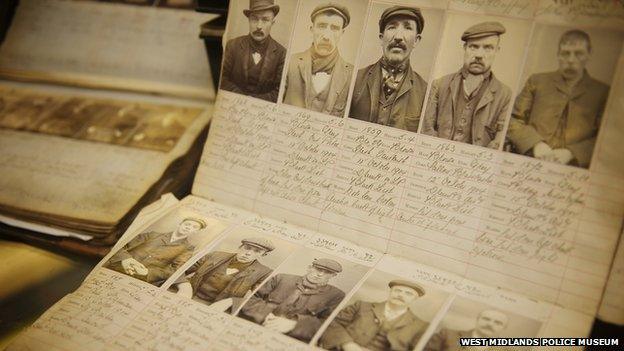
Records of the gang members and their crimes are preserved in Sparkhill's West Midlands Police Museum
The dank, slum streets are ruled by gangs made up of hundreds of youths armed with knives, razor blades and hammers.
Murders are rife. Robberies, thefts and riots are a daily occurrence at the hands of young gang members who hold the entire city in a fearful, bloody grip.
Police do their best to control the daily nightmare but are vastly outnumbered.
Welcome to Birmingham 1919.
Now - nearly a century later - a six-part drama series explores the lives of the members of the city's most notorious gang from a century ago - the Peaky Blinders.
Their chilling nickname was derived from the razor blades carefully stitched into the front of their caps which could be used to blind their victims.
But who were the gangs that inspired the BBC Two series, and why were they formed?
'Sloggers and brawlers'
From as early as the 1870s, inner-city Birmingham streets were filled with overcrowded slums and extreme poverty - and the lure of crime was a pull for some.
It soon led to an eruption of gangs and violence across the city.

The original Peaky Blinders - some of whom are pictured here - are to be portrayed in BBC2's new six-part series
Battles to "own" areas such as Small Heath and Cheapside broke out. These saw hundreds of youths fighting - sometimes to the death - in mass brawls that lasted for hours.
The most prominent - and ruthless - of these early gangs were known as the Sloggers, or the Cheapside Slogging Gang.
For 30 years they ruled the city's streets with protection rackets and violence.
Led by John Adrian, and his trusted lieutenant James Grinrod, they began their reign of terror in about 1870.
Their weapon of choice was a heavy-buckled belt used to pummel male and female victims of all ages into submission.
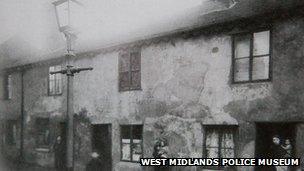
The Garrison Lane slums were home to Henry Lightfoot; one of the first to be referred to as a "Peaky Blinder"
An 1872 Birmingham Mail report records a typical example of the Sloggers' antics.
It states how "400 roughs brought indiscriminate violence to the Cheapside area, attacking and stealing".
"A small body of police were sent to deal with the Slogging Gang," the report continues.
"Officers made three arrests, including two very poor youths of no fixed home."
Notorious Sloggers included Aston's Simpson Brothers and George "Cloggy" Williams, whose notoriety grew quickly after the 1897 killing of PC George Snipe.
Many rival gangs formed, and one in particular soon became the most fearful force on the city's streets.
The Peaky Blinders as a gang were as deliberately stylish as they were violent.
'Blinders and blindness'
Historian David Cross, of the West Midlands Police Museum in Sparkhill, is curator of the country's largest collection of prisoner photographs.
The collection contains court papers which document the exploits of the city's bygone gangs.
"If you think of your grandfather's cap in those days, then it would have had a very hard peak," said Mr Cross.
"They used their hats with razor blades sewn in to rob people. That's what a Peaky Blinder was.
"When they hit someone or headbutted someone on the nose while wearing one, it would cause their victim temporary blindness."
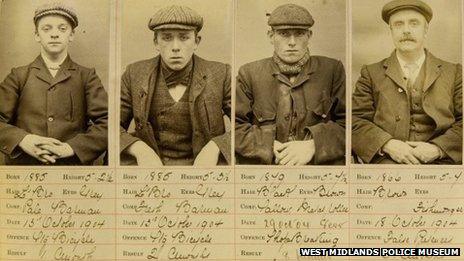
The Peaky Blinders members included Stephen McHickie, Tom Gilbert, Harry Fowler and Ernest Bayles
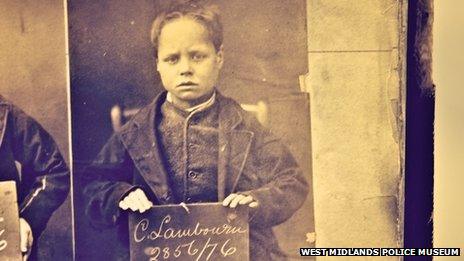
Many of the violent gang members were children, such as 12-year-old Charles Lambourne
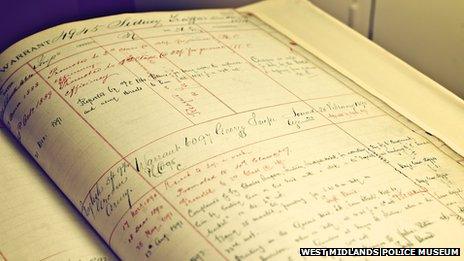
Details of the Peaky Blinders' crimes are preserved in the West Midlands Police Museum
Victims were chosen indiscriminately, regardless of whether they were male or female, young or old, rich or poor, according to Mr Cross.
"They would target anybody who looked vulnerable, or who did not look strong or fit," he said.
"Anything that could be taken, they would take it."
Their carefully stylised image was an attempt to bring a touch of class to their actions, Mr Cross said, as well as making them stand out from their rivals.
Peaky Blinders would wear a silk scarf tied around their necks, bell-bottom trousers and a flat, bladed cap tilted to one side.
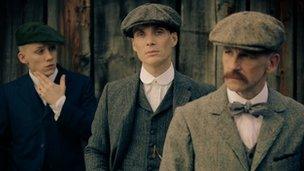
The new six-part BBC2 drama series charts the lives of some of the most notorious Peaky Blinders
Children, in the same desperate situation as adults, were also recruited regularly into the ranks.
Prominent members included 13-year-old David Taylor, jailed for carrying a gun, and 12-year-old Charles Lambourne.
Older gang members ruled the roost, such as Stephen McHickie, Harry Fowler and Tom Gilbert.
Members were loyal - and local legends. It was often impossible to tell how many fighters in a gang were actually Peaky Blinders, and how many were claiming to be simply for the status it gave them.
As families began to move out of the city centre in the early 20th Century, the rule of the gangs started to decline.
As areas such as Small Heath grew, so did the physical distance between the rivals.
Most of the once-feared names of the gang members are now forgotten, but their reputations are cemented in Birmingham's folklore.
Peaky Blinders is on BBC Two at 2100 BST and will be available on the iPlayer after.
- Published9 September 2013
- Published7 January 2013